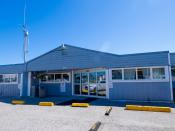Ultrasound is a non-invasive medical procedure that uses high-frequency sound waves to capture real-time images to monitor pregnancies, assess organs and soft tissues, and evaluate blood flow in blood vessels. This procedure can look at the structures of your body without the use of radiation or contrast dye.
What to expect
-
Preparing for your appointment
Patient preparation differs depending on which part of the body is being examined. Please make sure you follow the preparation instructions provided to you at the time the appointment was made. If you have not prepared properly we may not be able to complete your test and you may have to reschedule your appointment.
Arrival
Please arrive early for your appointment. Give yourself time to find parking and check in at Medical Imaging before your appointment. Bring a government-issued photo identification and your BC Services Card (personal health number).Duration
The duration of the ultrasound can vary depending on the type of test. The test can take anywhere between 30 minutes to 60 minutes or more.Meals
Depending on the type of ultrasound test, you might be asked to avoid eating or drinking for 12 hours before you arrive. You will be provided with specific instructions at the time of booking or from your health-care provider.Clothing
For your comfort, please wear clothing that can easily be moved out of the way or removed if necessary. In some appointments, you will be provided a hospital gown to change into.Bringing a support person
If you need a patient companion, they may accompany you before and after the scanning portion of the test. Your patient companion may be asked to wait outside the examination room during the scan. -
During the ultrasound scan
Room set-up
You will be taken to an examination room and asked to lie down on a stretcher. The room will typically be dimly lit to help the sonographer see the monitor and the images that are taken during the test. While the sonographer is scanning, they will not be able to turn the screen towards you.Gel application
A water-based gel will be applied to the area of your body that will be examined. This gel helps the ultrasound probe/transducer make better contact with your skin and allows sound waves to pass through more easilyComfort
Ultrasound examinations are generally painless. You will feel slight pressure as the sonographer moves the ultrasound transducer, but it is usually well-tolerated. -
Getting your scan results
The sonographers are registered and trained to perform your test. Radiologists are physicians who are qualified to read and interpret the images that the sonographer obtains during the test.
- For this reason, sonographers cannot discuss the results with you. The final report from the radiologist will be sent to your referring health care provider.
- The images captured during the ultrasound examination will be read and interpreted by a radiologist. Afterwards, they will send the final report to your health care provider with any findings and may provide recommendations.
The final report takes 2 to 3 business days to be sent to your referring health care provider. Urgent results will be phoned to your health care provider as soon as possible.
Resources
-
-
Having a prostate ultrasound
Information for patients having an prostate ultrasound (transrectal ultrasound or TRUS)
-
Having an ultrasound scan
Patient information on ultrasound imaging.
-
Having an endovaginal ultrasound scan
Information for patients undergoing an endovaginal ultrasound scan.
-
Having a prenatal ultrasound scan at 18 to 20 weeks
Patient information on prenatal ultrasound, also known as pregnancy or obstetrical ultrasound provides information about the baby's size and position, organs, heart rate, etc.
-
-
-
Medical imaging requisition form
-
How to access
A referral is required for an ultrasound. Have your physician complete the medical imaging requisition form and fax it to your closest clinic.
A member of the clinic team will then contact you to book your ultrasound appointment.
Find this service near you
-

Ultrasound at Gordon and Leslie Diamond Health Care Centre
899 West 12th Avenue Vancouver -

Ultrasound at Koerner Pavilion (UBC)
2211 Wesbrook Mall Vancouver -

Ultrasound at Lions Gate Hospital
231 East 15th Street North Vancouver -

Ultrasound at qathet General Hospital
5000 Joyce Avenue Powell River -

Ultrasound at Richmond Hospital
7000 Westminster Highway Richmond -

Ultrasound at Sechelt | shíshálh Hospital
5544 Sunshine Coast Highway Sechelt -

Ultrasound at Squamish General Hospital
38140 Behrner Drive Squamish -

Ultrasound at Whistler Health Care Centre
4380 Lorimer Road Whistler -

Ultrasound at ƛ̓uxválásu̓ilas Heiltsuk Hospital (Bella Bella)
88 Waglisla Street Bella Bella



